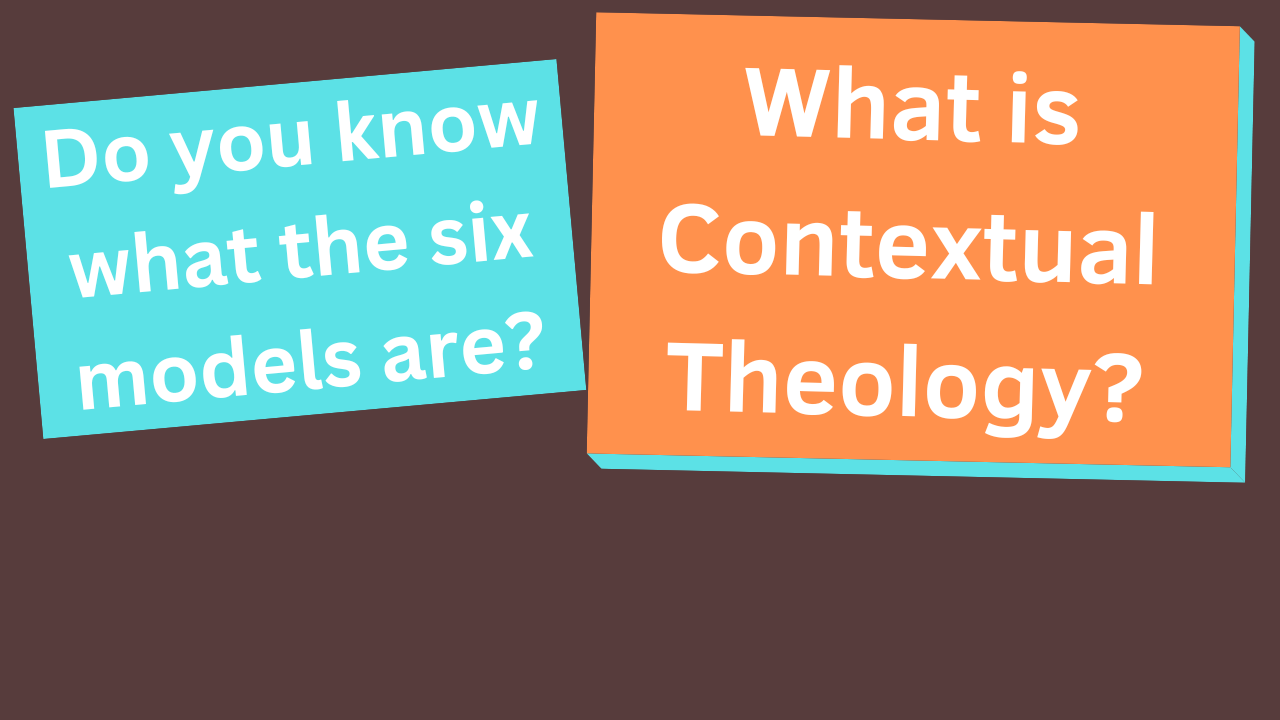06/05/2024 – What is Contextual Theology?

What is contextual theology? Can this be a helpful way to understand religion? If you wanna find out, check this out. This is TenOnReligion.
Hey peeps, it’s Dr. B. with TenOnReligion. If you like religion and philosophy content one thing I really need you to do is to smash that sub button because it really helps out the channel. The transcript is available at TenOnReligion.com and new episodes are posted about every two weeks at noon, U.S. Pacific time, so drop me some views.
There are a lot of works which explain contextual theology, but the main work which best describes the framework of the major options is a book by Steven Bevans titled, Models of Contextual Theology, originally written in 1992 and then later revised and expanded in 2002. This book starts out by explaining what contextual theology is and why it’s important and then proceeds to lay out six different models of contextual theology. Let’s get started.
So, what does the phrase “contextual theology” mean? Theology is just the field which seeks to understand who or what God is. This could be any religion – there is Jewish theology, Christian theology, Islamic theology, Hindu theology and so on. This book focuses on Christian theology but I think the principles are general enough that they can easily be adapted for other traditions. The contextual part simply means that we think and speak using the categories of our culture. Rather than using traditional Eurocentric categories for interpreting and understanding Christianity, for example, contextual theologians use the categories of whatever culture they are living in. This is due to the function of language in that you only have enough words to say whatever it is you want to say. If you don’t have a need to say something, then there are no words for it in your language. Certain Asian cultures have many different words in their language for the English-language word “rice” such as cooked rice, uncooked rice, fried rice, steamed rice, sticky rice, leftover rice, and many others. Tribal languages in and around the Sahara Desert in Africa have many different words for “camel” but have few or no words for “snow.” Tribal languages in and around northern Canada and Alaska have many different words for “snow” but have few or no words for “camel.” The geographical, cultural, and historical context we live in provides words and concepts which construct the very way we understand and communicate our perception of reality. Contextual theology grabs something from the past and communicates it through these very words and concepts. In a way, all theology is obviously contextual, but we usually don’t think about it that way. Now let’s turn to the models.
The six models fall on a continuum between experience of the present and experience of the past. The models are the countercultural model, the translation model, synthetic model, the praxis model, and then the anthropological model. The transcendental model doesn’t really fit well on the continuum so it kind of floats above it all. We’ll explain that later. We’re going to start on the left and work our way right and end with the transcendental model. As we’re going through them think of which one you like the most and why.
First, the countercultural model. This model basically holds the view that the religion’s historical tradition and scriptures need to challenge one’s current cultural context. Primacy goes to the tradition and scriptures such that it can critique the present context. Revelation of important events in the past are emphasized. It’s not entirely anticultural but it does have a negative bent on contemporary culture or towards contemporary culture. There is often a stress on conversion with a large gap between the insiders and the outsiders. Groups which fall under this model often are heavily exclusivist.
Second, the translation model. This does not mean a strict word-for-word translation of scriptures but translation of meaning, especially when it comes to idioms. The main idea is that there is some sort of essence or kernel of religion which is above all cultures and contexts. The context is subordinate to the religion, and there is some sort of implied assumption that all cultures have the same basic structure. It’s probably a mistake to assume that, but I’ll let you form your own opinion. Despite this, the translation model is probably the most popular of the six models and it is likely what one thinks of when one even uses the word theology.
Third, the synthetic model. This model is, simply put, a both/and model with respect to the mutual enrichment of cultures past and present. It synthesizes, or brings together, the religious messages and ideas of the past with the current cultural context in all of its social and historical changes. One lives in some sort of a dialogue in between both. It affirms both uniqueness and complementarity. To do contextual theology in the mindset of the synthetic model is less like following a strict set of guidelines and more like creating a work of art. It’s not a once-and-done thing but more like an ongoing process of conversation.
Fourth, the praxis model. This model is defined by its commitment to action and social transformation. Religion is not about right doctrines and ideas but right activity in the way we live our lives. How can one infuse the presence of religion within a culture such that it would have a positive effect? One analyzes their cultural context and then finds ways to adapt their religious ideas from scripture and tradition to identify and address particular needs. A good example of the praxis model, though not the only one, is liberation theology whereby one makes an effort to help the poor and other marginalized groups in a society. Liberation theology is very popular in Latinx and Asian cultures. The praxis model focuses on making religion both contemporary and relevant.
Fifth, the anthropological model. In this model, religion manifests itself in people and so the focus is on more general categories of human life and human experience. What are the deep questions people ask and how can religion answer them? This can change from cultural context to cultural context and the religious categories that people find important will vary in each case. It is less of a religious imposition than some of the other models and more of a realization or discovery of religion within one’s own culture. One of the possible downsides to this model is the possibility of a religious interpretation becoming too closely identified with a particular cultural context and therefore it becomes difficult to be understood outside of that context, much less be spread outside of it.
Sixth and last, the transcendental model. This model kind of floats above all of the other models because it is a little bit more philosophical. One starts with one’s own religious experience and with one’s own experience of oneself in a particular culture. Since one is part of one or more communities, they also play a part in the shaping process. A person struggles to slowly articulate and appropriate more adequately their ongoing religious journey. Though the content of religion will be different based on era, geographical location, and religious tradition, the basic cognitive operations will be quite similar. That’s why it’s transcendental – it transcends any given context. The emphasis is on the authenticity of people who are trying to express their religious faith and commitment. For some, however, this model is a little too abstract or hard to grasp.
So, now a few comments. Here’s all of the models again. I probably should have said this earlier, but the models aren’t necessarily exclusive. A person could analyze religion using more than one model, but perhaps some pairs of models might be more in tension with each other than other pairs of models. All in all, the idea of constructing models of contextual theology to help understand religion better is an interesting endeavor to think about. And that’s that.
So, what do you think about the different models of contextual theology? Is it a good way to help understand religion better? If so, which model did you find the most thought-provoking and why? Leave a comment below and let me know what you think. Until next time, stay curious. If you enjoyed this, support the channel in the link below, please like and share this video and subscribe to this channel. This is TenOnReligion.
Steven B. Bevans, Models of Contextual Theology, Revised and Expanded Edition (Orbis Books: Maryknoll, NY, 2002).


